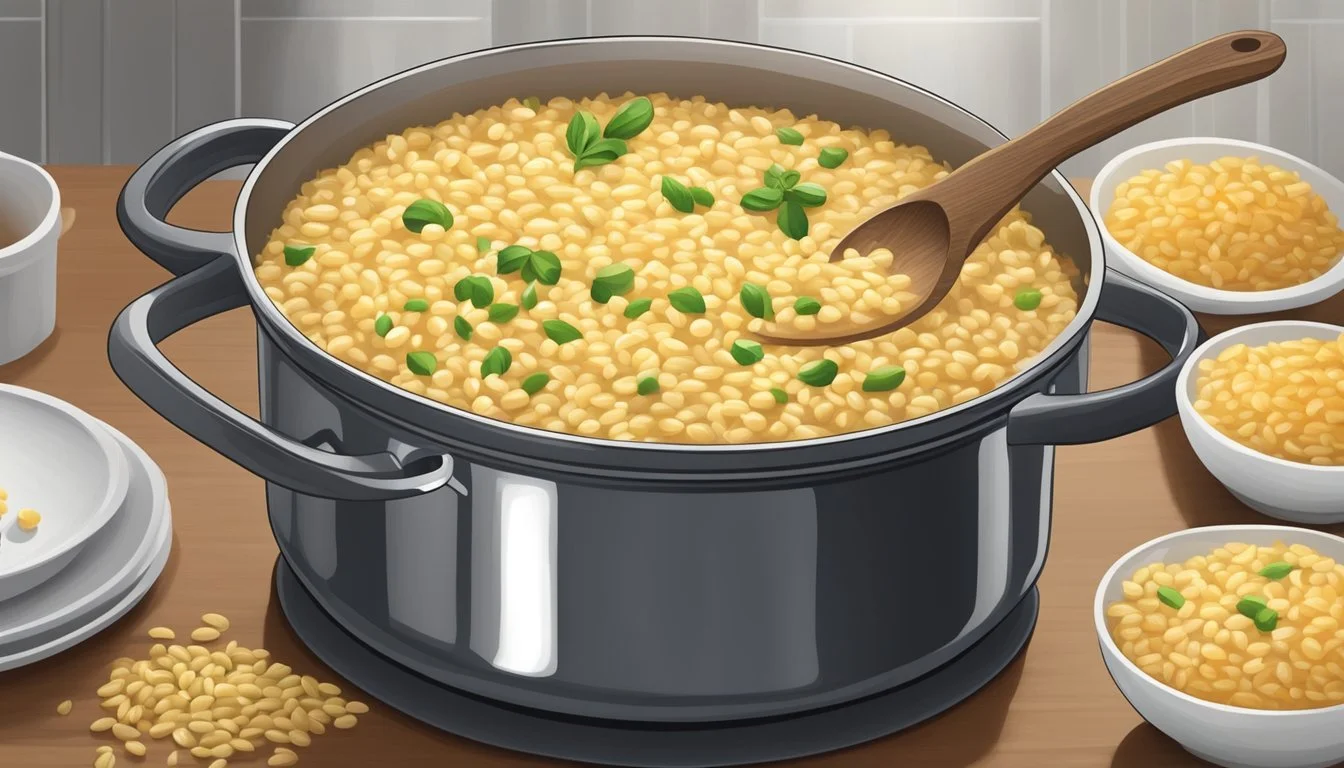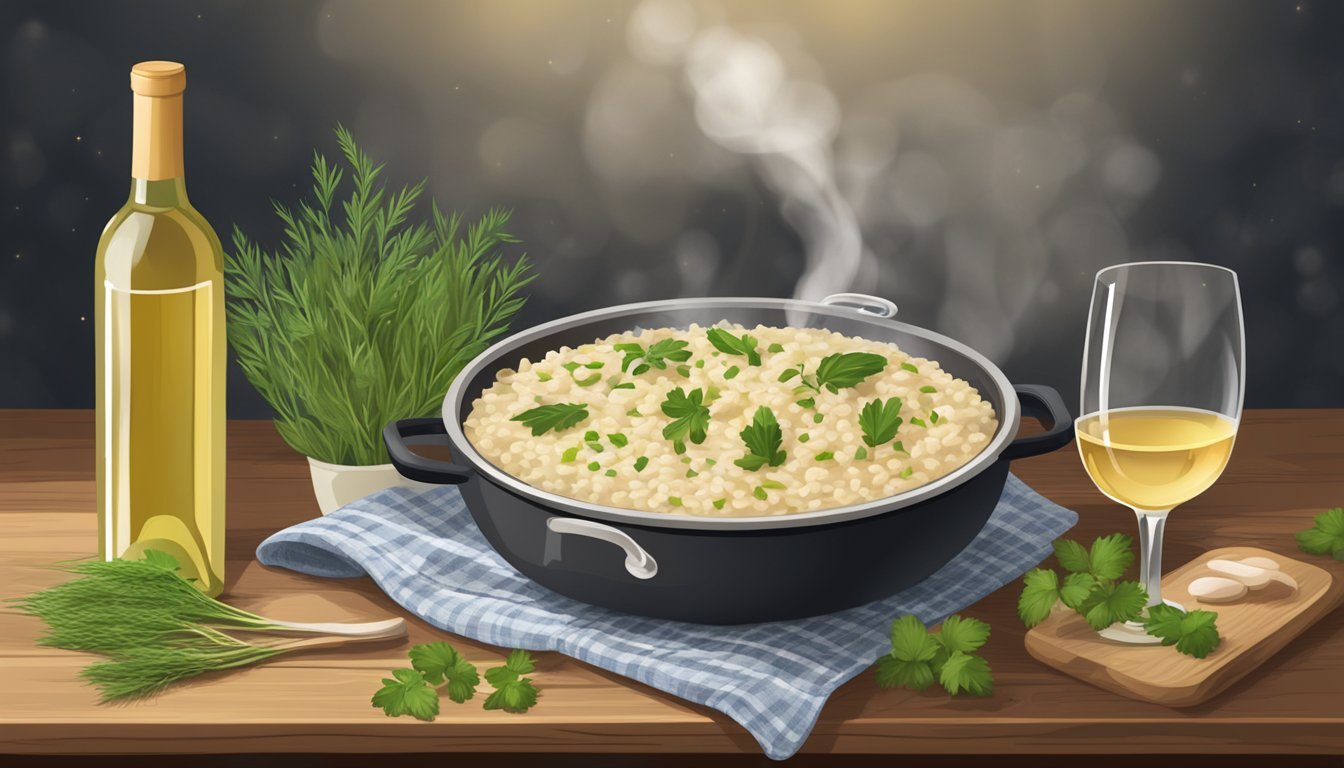How to Reheat Barley Risotto for Optimal Flavor and Texture
Reheating barley risotto can be a bit tricky, but with the right techniques, it can taste as delicious as when it was first made. To reheat barley risotto effectively, adding a little moisture—whether broth, water, or even a splash of wine—can help to maintain its creamy texture. Whether you're using the oven or microwave, ensuring the risotto doesn't dry out is key.
Using an oven for reheating allows for a gentle, even heat that suits barley risotto well. Preheat the oven to around 350°F (175°C), transfer the risotto to an oven-safe dish, and cover it with foil after adding some liquid to moisten it. Heating the dish for 10 to 15 minutes should bring back its savory appeal without overcooking.
For quicker reheating, the microwave can be a viable option. Place the risotto in a microwave-safe container, cover it loosely, and heat it on high power for about 3 minutes, stirring every 30-60 seconds for even heating. Sitting for an extra minute after heating helps achieve the best texture before serving.
Understanding Risotto and Its Composition
Risotto is a popular Italian dish known for its creamy texture and rich flavors. Barley risotto, in particular, brings a unique twist with its nutty flavor and chewy texture, largely due to its key ingredients and preparation techniques.
Key Ingredients in Barley Risotto
Barley: Unlike the traditional Arborio rice used in classic risotto, barley has a slightly chewy texture and a subtle nutty flavor. This grain is high in fiber and helps give the dish a hearty feel.
Vegetables and Mushrooms: Vegetables like onions, garlic, and celery, along with mushrooms, are often sautéed in olive oil or butter. They add layers of flavor and complement barley's texture.
White Wine: A dash of white wine is typically added, enhancing the dish with a tangy undertone that balances the richness of the other ingredients.
Broth: Gradual addition of warm broth (vegetable, chicken, or beef) is essential. It allows the barley to slowly release its starch, contributing to the dish’s creamy consistency.
Cheese and Butter: Grated cheese, like Parmesan, and a pat of butter are stirred in towards the end. These ingredients enhance the creaminess and add depth to the flavor profile.
The Science of Risotto's Creaminess
The creamy texture of risotto, including barley risotto, is primarily due to the high starch content of the grains and the cooking technique used.
When barley (or Arborio rice in traditional risotto) is cooked, it gradually releases starches into the cooking liquid. This starch is crucial for achieving the desired creaminess.
The constant stirring and slow addition of broth help release more starch from the barley. This process, combined with the absorption of the liquid, results in the signature rich and creamy texture.
Cheese and butter, added at the final stages, further enrich the dish. The fats in these ingredients blend with the starches, creating a velvety finish.
Understanding these elements is key to mastering risotto. Adjusting quantities and cooking times can perfect the balance of flavors and textures in your barley risotto.
Preparing for Reheating
Proper storage and careful preparation of leftover risotto are essential steps to ensure its flavor and texture remain intact when reheated.
Storage Best Practices
Storing leftover risotto correctly is crucial to maintain its quality. First, allow the risotto to cool to room temperature after cooking. This step prevents excess moisture from forming when stored.
Transfer the cooled risotto into an airtight container, which helps lock in moisture and prevent any unwanted odors from the refrigerator from seeping in. Store the container in the refrigerator if it will be consumed within a few days.
For longer storage, consider freezing the risotto. Portion the risotto into smaller servings to make reheating easier and ensure even consistency. Use a freezer-safe bag or container, removing as much air as possible to avoid freezer burn. Label the container with the date to keep track of its freshness.
Bringing Risotto to Room Temperature
Before reheating, bring the risotto to room temperature. This step helps ensure even heating and prevents the exterior from becoming too dry while the interior remains cold.
Remove the risotto from the refrigerator and leave it out for approximately 30 minutes. Cover the container loosely to protect it from contaminants.
In cases where the risotto was frozen, transfer it from the freezer to the refrigerator the night before to allow gradual thawing. This method preserves the texture and reduces the risk of becoming mushy or grainy when reheated.
By following these guidelines, the risotto is properly prepared for any reheating method, ensuring a delicious and satisfying meal.
Reheating Techniques for Barley Risotto
Reheating barley risotto can be done effectively using different methods to preserve its creamy texture and rich flavors. Each method has its specifics to ensure your dish remains as delightful as when it was originally made.
Stovetop Reheating Method
For this method, place the risotto in a non-stick pan on medium heat. Add a splash of vegetable broth or chicken broth to the risotto. Stir continuously to prevent sticking and ensure even heating.
Cover the pan to trap steam, which helps rehydrate the barley. Heat gently for around 5-7 minutes, stirring occasionally until the risotto is heated uniformly.
Add a small amount of water if it begins to dry out. Serve immediately once it reaches the desired temperature.
Oven Reheating Method
Preheat the oven to 350°F (175°C). Transfer the risotto to an oven-safe dish. Add a small amount of broth or water to prevent dryness.
Cover the dish tightly with aluminum foil to lock in moisture. Place the dish in the oven and heat for approximately 10-15 minutes.
Check and stir the risotto halfway through to ensure even warming. If it seems too thick, add more liquid and stir before covering and continuing to heat.
Microwave Reheating Method
Transfer the barley risotto into a microwave-safe container. Add a few tablespoons of water or broth, depending on the portion size. Cover the container with a loosely placed lid or paper towel to prevent splatters.
Heat on high power for 3 minutes, stopping every 30-60 seconds to stir. This allows for even distribution of heat and avoids overheating.
Let the risotto sit for a minute after microwaving before serving. Adjust seasoning if necessary and serve.
Creative Alternatives for Leftover Risotto
Leftover barley risotto can be transformed into new dishes. One option is to make risotto fritters. Form the cold risotto into small patties, then fry them in a non-stick pan with a bit of oil until golden and crispy on both sides.
Another option is to stuff bell peppers with reheated risotto. Scoop the risotto into the halved and hollowed peppers, then bake at 350°F (175°C) for about 20 minutes.
Alternatively, you can add the risotto to soups, using it to thicken and enrich the broth. This is particularly effective in vegetable or chicken soups.
Final Touches and Quality Control
Reheated barley risotto needs careful attention to restore its original flavor and texture. Focus on refining the seasoning and consistency to achieve a dish that's as delicious as the first time it was served.
Adjusting Seasonings and Consistency
After reheating, check the risotto’s flavor by tasting it.
Salt and pepper are essential for balance, so add small amounts incrementally and taste as you go. If the risotto lacks depth, a sprinkle of parmesan cheese or grated cheese can enhance its creaminess and overall rich flavor.
When it comes to consistency, add a little stock or water if the risotto seems too dry. Stir well to ensure even distribution of moisture.
Use a food thermometer to check the internal temperature, ensuring it reaches at least 165°F (74°C) for safe consumption. This step guarantees that the risotto is not just flavorful but also safe to eat.
Additional Tips for Success
When reheating barley risotto, certain techniques can help achieve a creamy consistency and enhance flavors. Proper methods ensure that reheated risotto remains delicious and enjoyable.
Mastering Creamy Consistency
To maintain a creamy texture, adding a bit of extra liquid is essential. Use broth, water, or a splash of white wine. Starch content is crucial for creaminess; gentle stirring helps release starch.
Heat risotto slowly on low heat. This prevents overcooking and ensures even warming. Using a pan, lightly moisten the risotto with your chosen liquid, and stir gently. For oven reheating, cover with foil to trap steam.
Olive oil or a small amount of butter can be added to enhance the creamy texture. A little cream can also be stirred in to maintain a smooth consistency.
Enhancing Flavors Post-Reheating
To boost flavors, consider adding some ingredients after reheating. Fresh herbs, a touch of grated cheese like Parmesan, or a drizzle of truffle oil can introduce new and enriched flavors.
Sautéing a few vegetables, such as mushrooms or spinach, and mixing them in adds freshness and depth. A splash of flavorful stock or a dash of wine can revive the risotto.
Using gentle heat preserves the integrity of the ingredients. Avoid high heat, which can ruin the delicate flavors and textures. Finish with a touch of olive oil or butter to enrich the taste and bring everything together beautifully.
Serving and Pairing Suggestions
When serving barley risotto, various accompaniments and side dishes can enhance the dish. Pairing it with complementary flavors can elevate the dining experience and provide a balanced meal.
Accompaniments and Side Dishes
Barley risotto pairs well with a variety of side dishes. A fresh green salad with a light vinaigrette adds a refreshing contrast. Steamed or roasted vegetables, such as asparagus or green beans, provide additional texture and flavor.
Cheese is an excellent companion to barley risotto. A sprinkle of Parmesan or Pecorino Romano on top enhances its creamy texture. For added richness, consider a serving of goat cheese on the side.
When it comes to wine, a light white wine like Sauvignon Blanc or Pinot Grigio complements the subtle flavors of the risotto. For those who prefer red wine, a Pinot Noir offers a light, fruity alternative.
Barley risotto can also be paired with simple sauces. A lemon butter sauce or a herb-infused olive oil can add a fresh and aromatic finish. Similarly, mushroom or pea soup served alongside can round out the meal.
Conclusion
Reheating barley risotto is an effective way to enjoy leftovers without compromising their texture and flavor.
The best method to reheat risotto is by using the oven. Preheat the oven to 350°F (175°C) and place the risotto in a baking dish. Add some broth or water to moisten it, then cover with foil. Heat for 10-15 minutes.
For quicker reheating, the microwave can be used. Place the chilled risotto in a microwave-safe bowl and add a splash of broth or water. Heat on medium-high for around 4 minutes, stirring halfway through.
Proper reheating ensures that the nutritional value of the risotto is maintained. Adding fresh herbs or a sprinkle of cheese can enhance its flavor.
Leftover risotto can also be repurposed into new recipes, such as risotto cakes or stuffed vegetables.
Barley risotto, when reheated correctly, remains a nutritious and delicious option for any meal.








